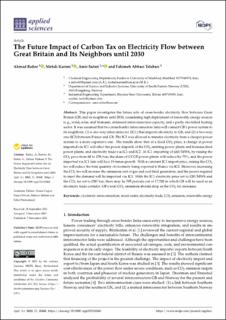| dc.contributor.author | Rafiee, Ahmad | |
| dc.contributor.author | Karimi, Mehdi | |
| dc.contributor.author | Safari, Amir | |
| dc.contributor.author | Talabari, Fahimeh Abbasi | |
| dc.date.accessioned | 2022-03-25T14:51:05Z | |
| dc.date.available | 2022-03-25T14:51:05Z | |
| dc.date.created | 2021-11-23T16:38:45Z | |
| dc.date.issued | 2021 | |
| dc.identifier.citation | Rafiee, A., Karimi, M., Safari, A. & Abbasi Talabari, F. (2021). The Future Impact of Carbon Tax on Electricity Flow between Great Britain and Its Neighbors until 2030. Applied Sciences, 11(21), Artikkel 10460. | en_US |
| dc.identifier.issn | 2076-3417 | |
| dc.identifier.uri | https://hdl.handle.net/11250/2987734 | |
| dc.description.abstract | This paper investigates the future role of cross-border electricity flow between Great Britain (GB) and its neighbors until 2030, considering high deployment of renewable energy sources (e.g., wind, solar, and biomass), enhanced interconnection capacity, and a partly electrified heating sector. It was assumed that two cross-border interconnectors links will connect GB’s power system to its neighbors: (1) a one-way interconnector (IC1) that imports electricity to GB, and (2) a two-way one (IC2) between France and GB. The IC2 was allowed to transfer electricity from a cheaper power system to a more expensive one. The results show that at a fixed CO2 price, a change in power imported via IC1 will affect the power dispatch of the CO2 emitting power plants and biomass-fired power plants, and electricity trade via IC1 and IC2. At IC1 importing of £60/MWh, by raising the CO2 price from 60 to £70/ton, the share of CCGT power plants will reduce by 75%, and the power imported via IC1 link will face 19-times growth. With a constant IC1 import price, raising the CO2 tax will reduce the total quantity of electricity being exported to France via IC2. Moreover, increasing the CO2 tax will increase the emissions cost of gas and coal-fired generators, and the power required to meet the demand will be imported via IC1. With the IC1 electricity price set to £20/MWh and the CO2 tax set to £50/ton, there may be 595 periods out of 17,520 in which GB will be used as an electricity trade corridor. GB’s total CO2 emissions should drop as the CO2 tax increases. | en_US |
| dc.language.iso | eng | en_US |
| dc.rights | Navngivelse 4.0 Internasjonal | * |
| dc.rights.uri | http://creativecommons.org/licenses/by/4.0/deed.no | * |
| dc.title | The future impact of carbon tax on electricity flow between great britain and its neighbors until 2030 | en_US |
| dc.type | Journal article | en_US |
| dc.type | Peer reviewed | en_US |
| dc.description.version | publishedVersion | en_US |
| dc.rights.holder | © 2021 by the authors. | en_US |
| dc.source.volume | 11 | en_US |
| dc.source.journal | Applied Sciences | en_US |
| dc.source.issue | 21 | en_US |
| dc.identifier.doi | https://doi.org/10.3390/app112110460 | |
| dc.identifier.cristin | 1958069 | |
| dc.source.articlenumber | 10460 | en_US |
| cristin.ispublished | true | |
| cristin.fulltext | original | |
| cristin.qualitycode | 1 | |

